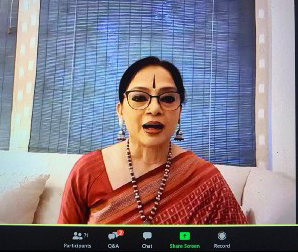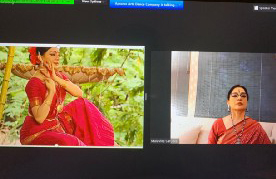When acclaimed Bharatanatyam dancer-choreographer decides to share her journey in re-imagining the solo, you know you are in for some precious lines you want to, as a dancer, remember, and keep re-visiting for life.
Excerpts from a lecture
Gratitude
“When I thought about the title, Re-imagining the solo Bharatnatyam dance performance, I wanted to pause and firstly acknowledge with gratitude the hereditary families and what they have done for us and for the dance. They are really the custodians of this art form; they treasured it, found their dignity through it and brought it to us despite setbacks and despite being marginalised.”

The Rigour of Dance
“Dance is a rather rigorous, unforgiving tradition. Practising it, day after day, is not easy; it’s a struggle, in fact but struggle is life.”
Starting Solo
“When I began dancing as a soloist, I must say had to approach it with caution, and with a sense of friendship but slowly I found myself going towards it. After around 15 years or so of training, I slowly started finding that classical dance was slowly starting to becoming a language. It took me a while to arrive at this clarity, so to speak but when I recognise that it was in fact, a vast, expansive language, it opened up for me so many vistas, possibilities allowing me to re-imagine it and turn to my inner voice and ask myself some important questions.
Dance is not merely about the aesthetics, the symmetry, the poetry, the metaphor… And then of course the incredible possibility of the adavus itself. Of course, all of this needs to be all this need to be kept in mind but finally it was also about finding a sense of inner alignment. And the more I look within, I began to experience dance as a moment of living vastness.”
The importance of intention
“Why should dancers ask themselves this question of intention. What is intention in dance. what is my intention? It is honestly the very being. When we change the intention, the awareness, the dance itself changes. The dancing body has many levels — physical, emotional and spiritual and it is all staggering but it’s crucial to locate these different realities within your being. Once that recognition happens and if and when these three strands come together — intertwine, so to speak — the performative becomes the artistic. And what unfolds is, magic!
Practice, practice, practice!
“Dance is so much about repetition and yet how can we, as dancers, individuals, keep afresh, refresh ourselves, every time we come to practice and perform in a way that we feel it for the first time. I think that quest has propelled me to ensure that despite the demands the dance makes on you, you have to always surrender to it because in surrender, there is strength.”
The Individual Feminine: “Khajuraho”
“I started re-imagining, Sringaram that is so prevalent (pradhanam) in the Bharatanatyam repertoire, we think of the woman, waiting for her beloved. At some point, early on when I began asking myself some pertinent questions about my dance, I remember seeing a miniature painting of a woman who was bold, passionate, stylised and sensuous. The more I looked at her, the more I was convinced of the need to celebrate her individual feminine desire that was all expansive and universalised rather than a mere coy decoration that is a stereotype of sorts.

The Divine Feminine: “Shakti Shaktimaan”
“I was initially very cautious to interpret the narrative of the Mahishasura Mardhini; I felt I didn’t have the language to entrust myself to depict her. But some life experiences prompted me to envision her energy and I thought of a sculpture I’d seen at Mamallapuram of the Mahishasura Mardhini and I felt a connection and I felt I was ready to move towards the interpretation. When we look at a sculpture, there’s a lot we can learn about how its maker interpreted it and also the body language of the sculpture itself can tell is a story. Because after all, dance is about observation, people, experiences. Dance doesn’t happen only in the dance class; it happens when you live life and continue to look around.”
The Ordinary, Extraordinary Woman: “Thimmakka”
“When I read a story of Thijmmakka on a flight, I felt the urgent need to tell the world her story. She was a woman of great spirit and her story is a story of how she changed the course of her life, turning grief into affirmation. I felt I had to dance her story. And let people celebrate the extraordinariness of this human being. The arts is meant to make us empathetic.
Outer to Inner: “Laya”
“My journey with Laya began with my intention to journey in abstract dance and to work with movement vocabulary to suggest a person who travels from the outer to the inner.”
This session was hosted by Vidhya Nair, Apsaras Arts.
Tomorrow, September 7, tune in at 4.30 pm — 5.30 pm (IST) for Dr S.Sowmya’s lecture on the Veena Dhanammal’s School of Padams
5.30 pm — 6.30 pm (IST) Rama Vaidyanathan — Tumris in Bharatanatyam









